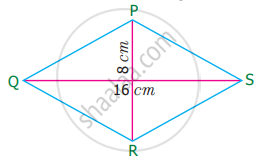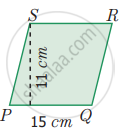Advertisements
Advertisements
प्रश्न
The figure ABCD is a quadrilateral in which AB = CD and BC = AD. Its area is ______.

पर्याय
72 cm2
36 cm2
24 cm2
18 cm2
उत्तर
The figure ABCD is a quadrilateral in which AB = CD and BC = AD. Its area is 36 cm2.
Explanation:

It is clear from the figure that, quadrilateral ABCD is a parallelogram. The diagonal AC of the given parallelogram ABCD divides it into two triangles of equal areas.
Area of the ΔABC =
=
= 18 cm2
∴ Area of parallelogram ABCD = 2 × Area of ΔABC
= 2 × 18
= 36 cm2
APPEARS IN
संबंधित प्रश्न
If length of a diagonal of a rhombus is 30 cm and its area is 240 sq cm, find its perimeter.
The length of the diagonals of a rhombus is in ratio 4 : 3. If its area is 384 cm2, find its side.
Find the area of rhombus PQRS shown in the following figure.
Find the area of rhombus PQRS shown in the following figure.
Find the missing value.
| Diagonal (d1) | Diagonal (d2) | Area |
| 26 m | 468 sq.m |
The area of the rhombus when both diagonals measuring 8 cm is
The height of the rhombus whose area 96 sq.m and side 24 m is
The angle between the diagonals of a rhombus is
Area of a quadrilateral ABCD is 20 cm2 and perpendiculars on BD from opposite vertices are 1 cm and 1.5 cm. The length of BD is ______.
The walls and ceiling of a room are to be plastered. The length, breadth and height of the room are 4.5 m, 3 m, and 350 cm respectively. Find the cost of plastering at the rate of Rs 8 per m2.
